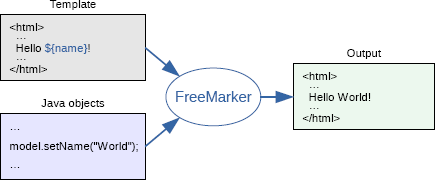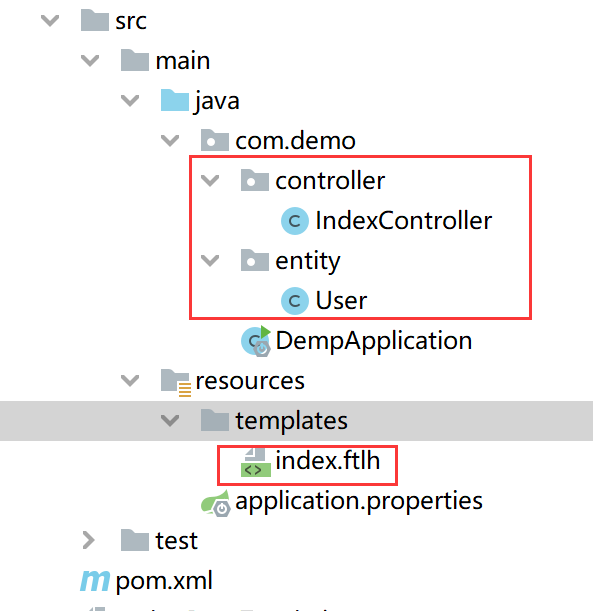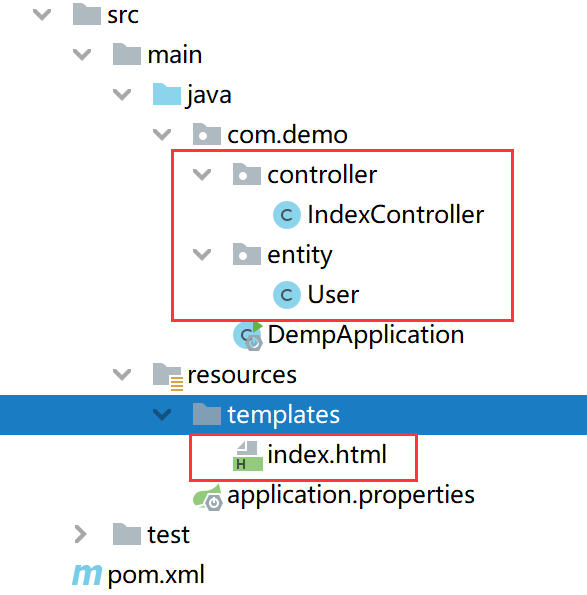Springboot整合模板引擎
整合Freemarker
Freemarker简介
这是一个相当老牌的开源的免费的模版引擎。通过 Freemarker 模版,我们可以将数据渲染成 HTML 网页、电子邮件、配置文件以及源代码等。Freemarker 不是面向最终用户的,而是一个 Java 类库,我们可以将之作为一个普通的组件嵌入到我们的产品中。
来看一张来自 Freemarker 官网的图片:

可以看到,Freemarker 可以将模版和数据渲染成 HTML 。
Freemarker 模版后缀为 .ftl(FreeMarker Template Language)。FTL 是一种简单的、专用的语言,它不是像 Java 那样成熟的编程语言。在模板中,你可以专注于如何展现数据, 而在模板之外可以专注于要展示什么数据。
POM文件增加依赖
<dependency>
<groupId>org.springframework.boot</groupId>
<artifactId>spring-boot-starter-freemarker</artifactId>
</dependency>创建类
创建实体类
public class User {
private Long id;
private String username;
private String address;
//省略 getter/setter
}创建Controller
@Controller
public class IndexController {
@RequestMapping("/index")
public String index(Model model) {
List<User> users = new ArrayList<>();
for (int i = 0; i < 10; i++) {
User user = new User();
user.setId((long) i);
user.setUsername("baiyp>>>>" + i);
user.setAddress("www.baiyp.ren>>>>" + i);
users.add(user);
}
model.addAttribute("users", users);
return "index";
}
}创建ftlh文件
<!DOCTYPE html>
<html lang="en">
<head>
<meta charset="UTF-8">
<title>Title</title>
</head>
<body>
<table border="1">
<tr>
<td>用户编号</td>
<td>用户名称</td>
<td>用户地址</td>
</tr>
<#list users as user>
<tr>
<td>${user.id}</td>
<td>${user.username}</td>
<td>${user.address}</td>
</tr>
</#list>
</table>
</body>
</html>目录结构

运行效果

显示配置freemarker
在springboot2.0+ 之后版本freemarker的默认后缀改成了ftlh,用原来的ftl直接访问会报错
可以显示配置为
配置application.properties
spring.freemarker.charset=UTF-8
spring.freemarker.suffix=.ftl
spring.freemarker.content-type=text/html; charset=utf-8
spring.freemarker.template-loader-path=classpath:/templates
spring.mvc.static-path-pattern=/static/**其他配置
# HttpServletRequest的属性是否可以覆盖controller中model的同名项
spring.freemarker.allow-request-override=false
# HttpSession的属性是否可以覆盖controller中model的同名项
spring.freemarker.allow-session-override=false
# 是否开启缓存
spring.freemarker.cache=false
# 模板文件编码
spring.freemarker.charset=UTF-8
# 是否检查模板位置
spring.freemarker.check-template-location=true
# Content-Type的值
spring.freemarker.content-type=text/html
# 是否将HttpServletRequest中的属性添加到Model中
spring.freemarker.expose-request-attributes=false
# 是否将HttpSession中的属性添加到Model中
spring.freemarker.expose-session-attributes=false
# 模板文件后缀
spring.freemarker.suffix=.ftl
# 模板文件位置
spring.freemarker.template-loader-path=classpath:/templates/原理分析
FreeMarkerAutoConfiguration
工程创建完成后,在
org.springframework.boot.autoconfigure.freemarker.FreeMarkerAutoConfiguration类中,可以看到关于 Freemarker 的自动化配置:
@Configuration(
proxyBeanMethods = false
)
@ConditionalOnClass({freemarker.template.Configuration.class, FreeMarkerConfigurationFactory.class})
@EnableConfigurationProperties({FreeMarkerProperties.class})
@Import({FreeMarkerServletWebConfiguration.class, FreeMarkerReactiveWebConfiguration.class, FreeMarkerNonWebConfiguration.class})
public class FreeMarkerAutoConfiguration {
}从这里可以看出,当 classpath 下存在 freemarker.template.Configuration 以及 FreeMarkerConfigurationFactory 时,配置才会生效,也就是说当我们引入了 Freemarker 之后,配置就会生效。但是这里的自动化配置只做了模板位置检查,其他配置则是在导入的 FreeMarkerServletWebConfiguration 配置中完成的。
FreeMarkerServletWebConfiguration
那么我们再来看看 FreeMarkerServletWebConfiguration 类,部分源码如下:
@Configuration(
proxyBeanMethods = false
)
@ConditionalOnWebApplication(
type = Type.SERVLET
)
@ConditionalOnClass({Servlet.class, FreeMarkerConfigurer.class})
@AutoConfigureAfter({WebMvcAutoConfiguration.class})
class FreeMarkerServletWebConfiguration extends AbstractFreeMarkerConfiguration {
protected FreeMarkerServletWebConfiguration(FreeMarkerProperties properties) {
super(properties);
}
@Bean
@ConditionalOnMissingBean({FreeMarkerConfig.class})
FreeMarkerConfigurer freeMarkerConfigurer() {
FreeMarkerConfigurer configurer = new FreeMarkerConfigurer();
this.applyProperties(configurer);
return configurer;
}
@Bean
@ConditionalOnMissingBean(
name = {"freeMarkerViewResolver"}
)
@ConditionalOnProperty(
name = {"spring.freemarker.enabled"},
matchIfMissing = true
)
FreeMarkerViewResolver freeMarkerViewResolver() {
FreeMarkerViewResolver resolver = new FreeMarkerViewResolver();
this.getProperties().applyToMvcViewResolver(resolver);
return resolver;
}
@Bean
@ConditionalOnEnabledResourceChain
@ConditionalOnMissingFilterBean({ResourceUrlEncodingFilter.class})
FilterRegistrationBean<ResourceUrlEncodingFilter> resourceUrlEncodingFilter() {
FilterRegistrationBean<ResourceUrlEncodingFilter> registration = new FilterRegistrationBean(new ResourceUrlEncodingFilter(), new ServletRegistrationBean[0]);
registration.setDispatcherTypes(DispatcherType.REQUEST, new DispatcherType[]{DispatcherType.ERROR});
return registration;
}
}我们来简单看下这段源码:
- @ConditionalOnWebApplication 表示当前配置在 web 环境下才会生效。
- ConditionalOnClass 表示当前配置在存在 Servlet 和 FreeMarkerConfigurer 时才会生效。
- @AutoConfigureAfter 表示当前自动化配置在 WebMvcAutoConfiguration 之后完成。
- 代码中,主要提供了 FreeMarkerConfigurer 和 FreeMarkerViewResolver
- FreeMarkerConfigurer 是 Freemarker 的一些基本配置,例如 templateLoaderPath、defaultEncoding 等
- FreeMarkerViewResolver 则是视图解析器的基本配置,包含了viewClass、suffix、allowRequestOverride、allowSessionOverride 等属性。
FreeMarkerProperties
另外还有一点,在这个类的构造方法中,注入了 FreeMarkerProperties:
@ConfigurationProperties(
prefix = "spring.freemarker"
)
public class FreeMarkerProperties extends AbstractTemplateViewResolverProperties {
public static final String DEFAULT_TEMPLATE_LOADER_PATH = "classpath:/templates/";
public static final String DEFAULT_PREFIX = "";
public static final String DEFAULT_SUFFIX = ".ftlh";
private Map<String, String> settings = new HashMap();
private String[] templateLoaderPath = new String[]{"classpath:/templates/"};
private boolean preferFileSystemAccess = true;
public FreeMarkerProperties() {
super("", ".ftlh");
}
public Map<String, String> getSettings() {
return this.settings;
}
public void setSettings(Map<String, String> settings) {
this.settings = settings;
}
public String[] getTemplateLoaderPath() {
return this.templateLoaderPath;
}
public boolean isPreferFileSystemAccess() {
return this.preferFileSystemAccess;
}
public void setPreferFileSystemAccess(boolean preferFileSystemAccess) {
this.preferFileSystemAccess = preferFileSystemAccess;
}
public void setTemplateLoaderPath(String... templateLoaderPaths) {
this.templateLoaderPath = templateLoaderPaths;
}
}FreeMarkerProperties 中则配置了 Freemarker 的基本信息,例如模板位置在 classpath:/templates/ ,再例如模板后缀为 .ftlh,那么这些配置我们以后都可以在 application.properties 中进行修改。
主要:在springboot 2.0+之后Freemarker 后缀改成了ftlh,如果还是使用的ftl后缀需要显示配置。
如果我们在 SSM 的 XML 文件中自己配置 Freemarker ,也不过就是配置这些东西。现在,这些配置由 FreeMarkerServletWebConfiguration 帮我们完成了。
整合 Thymeleaf
Thymeleaf 简介
Thymeleaf 是新一代 Java 模板引擎,它类似于 Velocity、FreeMarker 等传统 Java 模板引擎,但是与传统 Java 模板引擎不同的是,Thymeleaf 支持 HTML 原型。
它既可以让前端工程师在浏览器中直接打开查看样式,也可以让后端工程师结合真实数据查看显示效果,同时,SpringBoot 提供了 Thymeleaf 自动化配置解决方案,因此在 SpringBoot 中使用 Thymeleaf 非常方便。
事实上, Thymeleaf 除了展示基本的 HTML ,进行页面渲染之外,也可以作为一个 HTML 片段进行渲染,例如我们在做邮件发送时,可以使用 Thymeleaf 作为邮件发送模板。
另外,由于 Thymeleaf 模板后缀为 .html,可以直接被浏览器打开,因此,预览时非常方便。
POM文件增加依赖
<dependency>
<groupId>org.springframework.boot</groupId>
<artifactId>spring-boot-starter-thymeleaf</artifactId>
</dependency>创建类
实体类
参考下Freemarker 里面的User对象
创建Controller
参考下Freemarker 的controller
在 IndexController 中返回逻辑视图名+数据,逻辑视图名为 index ,意思我们需要在 resources/templates 目录下提供一个名为 index.html 的 Thymeleaf 模板文件。
创建 Thymeleaf
<!DOCTYPE html>
<html lang="en" xmlns:th="http://www.thymeleaf.org">
<head>
<meta charset="UTF-8">
<title>Title</title>
</head>
<body>
<table border="1">
<tr>
<td>编号</td>
<td>用户名</td>
<td>地址</td>
</tr>
<tr th:each="user : ${users}">
<td th:text="${user.id}"></td>
<td th:text="${user.username}"></td>
<td th:text="${user.address}"></td>
</tr>
</table>
</body>
</html>在 Thymeleaf 中,通过 th:each 指令来遍历一个集合,数据的展示通过 th:text 指令来实现,
注意 index.html 最上面要引入 thymeleaf 名称空间。
目录结构

运行效果
配置完成后,就可以启动项目了,访问 /index 接口,就能看到集合中的数据了:

原理分析
ConfigurationProperties
Thymeleaf 不仅仅能在 Spring Boot 中使用,也可以使用在其他地方,只不过 Spring Boot 针对 Thymeleaf 提供了一整套的自动化配置方案,这一套配置类的属性在 org.springframework.boot.autoconfigure.thymeleaf.ThymeleafProperties 中,部分源码如下:
@ConfigurationProperties(
prefix = "spring.thymeleaf"
)
public class ThymeleafProperties {
private static final Charset DEFAULT_ENCODING;
public static final String DEFAULT_PREFIX = "classpath:/templates/";
public static final String DEFAULT_SUFFIX = ".html";
private boolean checkTemplate = true;
private boolean checkTemplateLocation = true;
private String prefix = "classpath:/templates/";
private String suffix = ".html";
private String mode = "HTML";
private Charset encoding;
private boolean cache;
private Integer templateResolverOrder;
private String[] viewNames;
private String[] excludedViewNames;
private boolean enableSpringElCompiler;
private boolean renderHiddenMarkersBeforeCheckboxes;
private boolean enabled;
private final ThymeleafProperties.Servlet servlet;
private final ThymeleafProperties.Reactive reactive;
public ThymeleafProperties() {
this.encoding = DEFAULT_ENCODING;
this.cache = true;
this.renderHiddenMarkersBeforeCheckboxes = false;
this.enabled = true;
this.servlet = new ThymeleafProperties.Servlet();
this.reactive = new ThymeleafProperties.Reactive();
}
...
}- 首先通过 @ConfigurationProperties 注解,将 application.properties 前缀为 spring.thymeleaf 的配置和这个类中的属性绑定。
- 前三个 static 变量定义了默认的编码格式、视图解析器的前缀、后缀等。
- 从前三行配置中,可以看出来,Thymeleaf 模板的默认位置在 resources/templates 目录下,默认的后缀是 html 。
- 这些配置,如果开发者不自己提供,则使用 默认的,如果自己提供,则在 application.properties 中以 spring.thymeleaf 开始相关的配置。
ThymeleafAutoConfiguration
而我们刚刚提到的,Spring Boot 为 Thymeleaf 提供的自动化配置类,则是
org.springframework.boot.autoconfigure.thymeleaf.ThymeleafAutoConfiguration,部分源码如下:
@Configuration(
proxyBeanMethods = false
)
@EnableConfigurationProperties({ThymeleafProperties.class})
@ConditionalOnClass({TemplateMode.class, SpringTemplateEngine.class})
@AutoConfigureAfter({WebMvcAutoConfiguration.class, WebFluxAutoConfiguration.class})
public class ThymeleafAutoConfiguration {
...
}可以看到,在这个自动化配置类中,首先导入 ThymeleafProperties ,然后 @ConditionalOnClass 注解表示当当前系统中存在 TemplateMode 和 SpringTemplateEngine 类时,当前的自动化配置类才会生效,即只要项目中引入了 Thymeleaf 相关的依赖,这个配置就会生效。
这些默认的配置我们几乎不需要做任何更改就可以直接使用了。如果开发者有特殊需求,则可以在 application.properties 中配置以 spring.thymeleaf 开头的属性即可。










